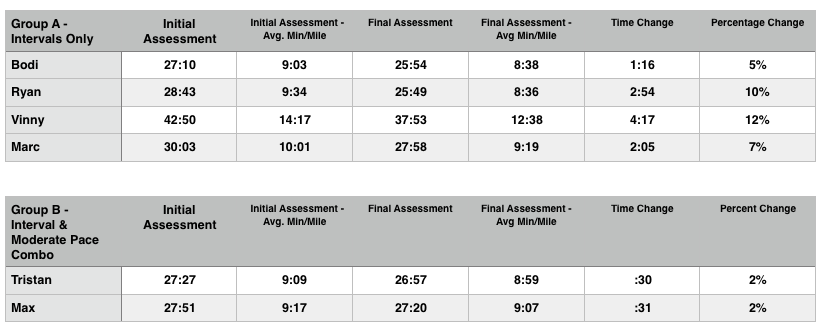
By Charlie Bausman
MTI’s Tactical Lab Rats completed another “Geek” Cycle, which focused on testing two progression methodologies for improving short distance rucking speed.
The Lab Rats conducted an initial 3-mile ruck run assessment with a 45# load. They were then split into two groups for a 3-week cycle, each rucking 2x/week.
Group A completed 3x 1-mile threshold interval ruck runs 2x/week, utilizing our MTI Ruck Calculator to find their assessment based on interval time.
Group B completed the same 3x 1-mile interval progression for one day, and a 5-mile ruck run at moderate pace for the second day. Group B also used the MTI Ruck Calculator to find the interval pace and moderate pace for the longer ruck.
Below is the outline of both Group’s training cycle over the last 3 weeks.
Group A: Interval Only Group

Group B: Interval and Long, Moderate Pace Group

All assessments and progressions were conducted on a 400m track, and the ruck load remained constant at 45#.
Results & Discussion

We initially had eight total lab rats for this cycle, but two athletes from Group B dropped during the cycle. This obviously gives us a much smaller amount of data for Group B. Despite this, we think we can still pull conclusions from this Geek Cycle.
The most interesting comparison is between Ryan (Group A) and Tristan (Group B). Ryan and Tristan are twins, both preparing to enter the military after graduating from high school this past spring. Physically, they are very similar. Ryan is slightly stronger in the weight room, and Tristan is a slightly faster runner. The differences are so slight that it’s almost negligible. Both are very tough.
Despite Tristan having a faster initial assessment time, Ryan passed him in terms of overall improvement and in direct comparison on the final assessment. Ryan did intervals only, while Tristan did the interval/moderate pace combo.
Overall, we can see that that Group A (interval group) had a higher average rate of improvement at 8% compared to the 2% average improvement of Group B (Intervals and Moderate Pace). While our sample size is small, the results are hard to ignore. We are confident in saying that for short distance rucking speed, intervals are a more efficient method of training in terms of training time and results.
The next question for rucking is how interval training effects longer distance rucking. The 12-mile ruck assessment is common in many military schools and selections. Our selection plans focus on developing speed through longer intervals, usually at 1/3 of the total assessment distance and 20% faster than the per-mile pace on the assessment. Will the same lessons from this study correlate to longer distance rucking?
A further question is the role of loading. Would interval training have similar effects with a higher load – say 75 pounds?
More to follow …
Questions, Comments, Feedback? Email coach@mtntactical.com
You Might Also Like MTI’s Rucking Improvement Plan
